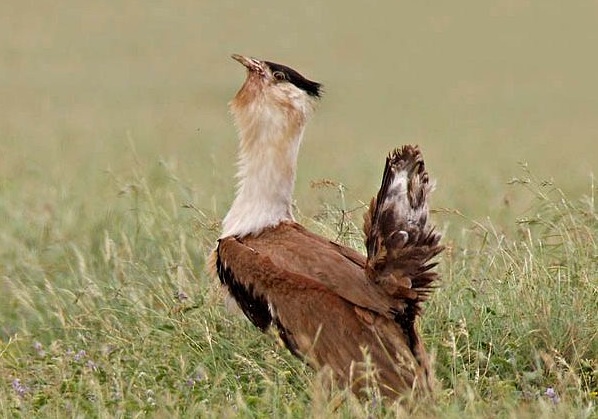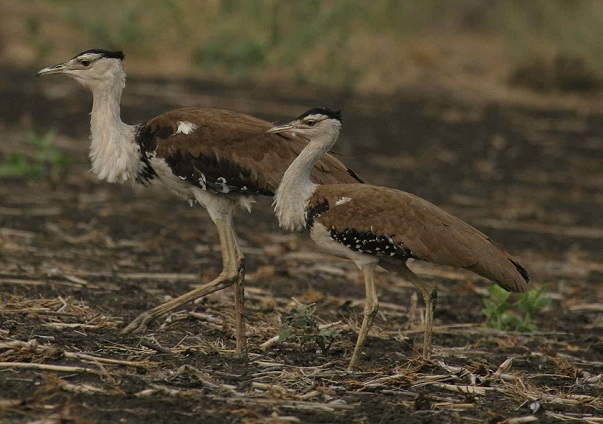The Red List | Great Indian Bustard



Do you know these facts?
Tribal Bhils are claimed to have used a technique for trapping females that involves setting twigs on fire around the nest containing an egg or chick. The female was then said to run to the nest and singe its wings upon which the tribals captured it.
The attempts to breed these birds in captivity have failed.
Great Indian Bustard (GIB) is a large and rare ground bird found in India and Pakistan. It is considered as one of the rarest bird in the region and the population declining day by day. It was considered to be a top gaming bird. The centuries of hunting just for flesh and game has brought the species population near to extinct.
Where is it found?
The Great Indian Bustard is locally extinct from 90% of its former range. It is currently found in small pockets of India and Pakistan. Once widely spread across the Indian subcontinent in the grassy, the species has seen drastic fall in its population in last two decades. Now estimated as just around 300 in population, the experts are considering this species as critically endangered. The current stronghold of the species is Thar desert of western India and Deccan peninsula in South. A few of them are believed to be surviving Sind of Pakistan. It inhabits arid and semi-arid grasslands with scattered low scrub, bushes and cultivation in flat or gently undulating terrain. It normally shares its habitat with Black Buck, Chinkara, Nilgai, Red Fox, wild cats etc. They make local movements but these are not well understood although it is known that populations disperse after the monsoons. Males are said to be solitary during the breeding season but form small flocks in winter. Males may however distribute themselves close together. Recently the birds have abandoned a remote village of Karnataka, India for unknown reason. According to the wildlife enthusiasts they even abandoned their eggs!
How does it live?
The Great Indian Bustard is omnivorous, feeding on grass seeds, berries of Zizyphus, Eruca, insects (mainly orthoptera, but also beetles, particularly Mylabris sp.), rodents and reptiles. In cultivated areas, they feed on crops such as exposed groundnut, millets and pods of legumes. They drink water whenever available. The breeding season is from March to September during which time the inflated fluffy white feathers of the male are inflated and displayed. They are believed to use a mating system that has been termed as an exploded or dispersed lek. The males are polygamous. The female lays a single egg in an unlined scrape on the ground. Only the females are involved in incubation and care of the young.
How does it look?
The Great Indian Bustard has a black cap contrasting with the pale head and neck. The body is brownish with a black patch spotted in white. It stands at about a metre high(39 in) and is a large, brown and white bird, the male is about 122 cm (48 in) in length, its weight is 18–32 lb (8–14.5 kg) and the female 92 cm (36 in) in length, its weight is 7.8–15 lb (3.5–6.75 kg). The male is deep sandy buff coloured and during the breeding season has a black breast band. The crown of the head is black and crested and is puffed up by displaying males. In the female which is smaller than the male, the head and neck are not pure white and the breast band is either rudimentary, broken or absent. Hunting records mention birds weighing from 21 to nearly 40 pounds.
What are the threats?
Tribal Bhils are claimed to have used a technique for trapping females that involves setting twigs on fire around the nest containing an egg or chick. The female was then said to run to the nest and singe its wings upon which the tribals captured it.
7 Comments For This Post
Leave a Reply
MOST CONCERNED ENDANGERED SPECIES
- Kashmir Stag (Hangul) - 229 votes
- Iberian Lynx - 154 votes
- Great Indian Bustard - 150 votes
- Long-Tailed Chinchilla - 138 votes
- Greater One Horned Rhino - 100 votes
- Orange-bellied Parrot - 95 votes
- Snow Leopard - 92 votes
- Red Panda - 82 votes
- Mekong Giant Catfish - 82 votes
- Tiger - 63 votes
-
CATEGORIES
- Amphibian (1)
- Bird (2)
- Conservation (10)
- Environment (4)
- Featured (5)
- Fish (2)
- Heavens on Earth (2)
- Mammal (11)
- Nature's Facts (8)
- Nature's Wonders (9)
- News (13)
- Red List of Endangered Species (18)
- Reptile (2)
- Wildlife (4)
-
ARCHIVES
- January 2013 (2)
- December 2012 (1)
- July 2012 (1)
- June 2012 (13)
- May 2012 (20)
- April 2012 (15)
- March 2012 (1)
- December 2011 (1)
- November 2011 (1)
- October 2011 (1)
- June 2011 (1)
- May 2011 (2)
- April 2011 (2)
- February 2011 (2)
- January 2011 (5)
- December 2010 (2)
- November 2010 (1)
- October 2010 (1)
- April 2010 (1)



 (150 votes, average: 1.00 out of 1)
(150 votes, average: 1.00 out of 1)
May 1st, 2013 at 3:37 pm
GREAT INDIAN BUSTARD IS AS GREAT IT IS AND MOST RARE SPECIES..
September 16th, 2013 at 2:28 pm
995 of the species that have ever lived have gone extinct,mostly for us. The Great Indian Bustard is a very rare species which is endangered. It is our duty to save them.
October 18th, 2013 at 8:08 pm
Ok…its endangered specis but what would be mesure we take to save this bird
January 4th, 2014 at 11:49 am
thankyou for suchnice information
May 21st, 2014 at 12:20 am
I think you have noted some very interesting points , appreciate it for the post. ekggdbbeafeb
April 3rd, 2015 at 2:08 pm
GIB is critically endangered it’s our duty protect
August 14th, 2015 at 5:26 pm
I think i seen this bird at back of my home in a pair. Plz help me how can i recognize them